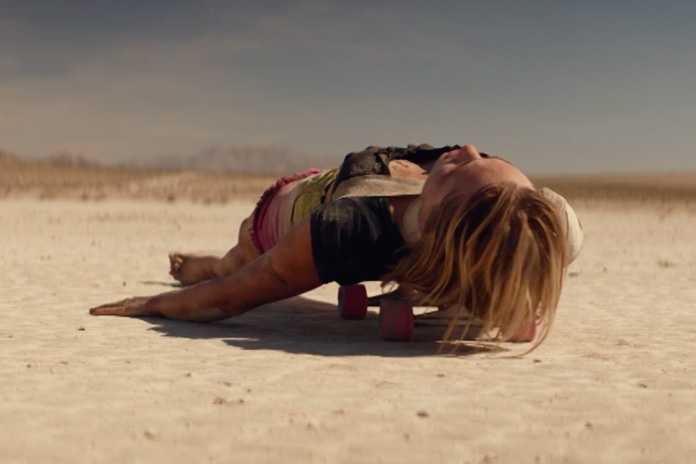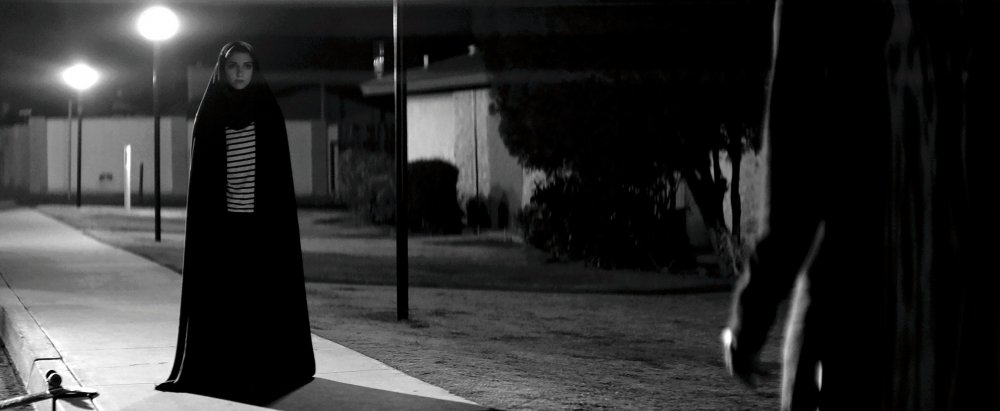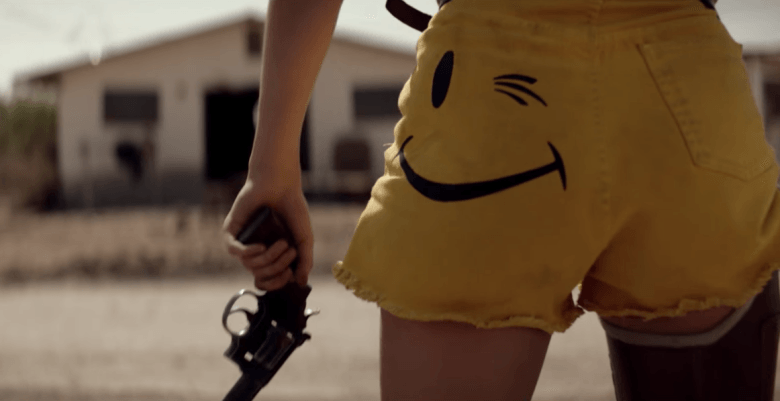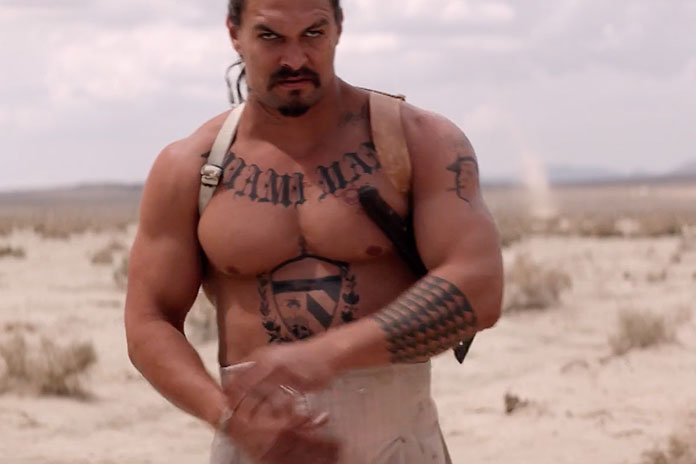
Early on in Ana Lily Amirpour’s The Bad Batch, a girl wearing watermelon-printed shorts rolls herself across the desert while lying down on a skateboard. She’s missing an arm and a leg. An amputee on an arduous journey across a desert – tape a Tarot card to her chest and you’ve got yourself the beginning of a Jodorowsky movie.
The Bad Batch is as hard a film to classify as one of Alejandro’s surrealistic joints. Is it a horror movie? It has cannibals and a few dismemberments. Is it a Western? It’s got people engaged in squint-heavy Mexican standoffs in the desert. Is it science fiction? It seems to take place in a dystopian future. Is it a love story? There’s some flirting and meet cutes and love overcoming Capulet/Montague type beefing. Is this whole film probably just an excuse to film Jason Momoa with his shirt off? All signs point to yes.
Taking place in a not-too distant future where the U.S. exiles “bad batch” individuals (undesirables who are “too weird, too old, not healthy enough, not rich enough”) to a blistering hot No Man’s Land outside Texas, The Bad Batch doesn’t spend much time on world-building. It throws us right into the action, with our heroine Arlen (played by Suki Waterhouse) pushed out into this lawless zone by border cops. She quickly discovers that there’s two encampments out in the desert: The Bridge, home to weight-lifting cannibals; and Comfort, a more civilized community run by a drug dealer/cult leader named The Dream.
Amirpour doesn’t delve into the specifics of how this world works: why the practice of bad batching exists, how these communities operate (where does Comfort get all its drugs and electricity?), or even why most of these characters have been exiled in the first place. The film’s dystopian concept seems more like a justification for Amirpour and her set designers to play around with Mad Max tropes and create crazy looking communities. The film’s aesthetics are an interesting case of “all things return to the source”: you could see the inspiration that folks at Burning Man drew from Mad Max, and now we’ve finally got a post-apocalyptic movie that draws its cues from Burning Man itself (The town of Comfort looks like Burning Man’s playa mashed together with a FEMA camp).
 A Girl Walks Home Alone at Night
A Girl Walks Home Alone at Night
Like her previous film, A Girl Walks Home Alone at Night, The Bad Batch is a film where style puts substance in a sleeper hold. This isn’t a bad thing – ask me to make a list of the best movies that came out in the last five years and I’d put A Girl Walks near the top of it. That film was a sleek, sensual black and white dream. Imagine the French New Wave trying to make an Iranian vampire movie. Everything about that film felt fresh and new, even though you could see the fingerprints of Amirpour’s idols all over the place. It wasn’t a film that could open doors to new philosophies in your mind, but it was sexy, lush, clever, and looked like a million bucks.
The Bad Batch is not a film of ideas either. It’s a film about provocative images and compositions: a shirtless Momoa strutting around in white pants (his Miami Man would make a killer Halloween costume for any buff male cinephile); the sight of a battered Arlen rolling on that skateboard; Keanu Reeves’ The Dream, rocking shades and hair that looked like they were lifted off Elvis after he met Nixon, protected by a cadre of pregnant bodyguards; a DJ blasting beats at night inside a trailer redesigned to look like a neon boombox; the cannibal town, built out of crashed airplanes, with the cannibals flexing and posing for the camera like they were doing a Muscle Beach beefcake calendar. It’s like someone took Jodorowsky, Six-String Samurai, and a bad trip at Coachella and blended them together to make for one hell of a heat stroke hallucination.
Speaking of hallucinations: The Bad Batch also depicts one of the most realistic drug trips I’ve ever seen in a movie.

One of the most striking aspects about The Bad Bunch is how good it is as a “silent” movie. There’s very little dialogue in the first hour of the film, and yet it remains compelling throughout. The only person who really gets to talk for awhile is Reeves, whose cult leader is barely in the film but gets to gab for longer than either of the two main characters.
The less talking, the better: the film’s biggest weakness is the voice work done by Waterhouse and Momoa. The two actors are fine when they hold their tongues: Momoa plays his brooding single dad/cannibal with just the right amount of resignation and intensity, while Waterhouse embodies her character’s wary, on-the-defensive nature. The two actors are gorgeous people who are great at doing expressive and convincing physical work: it’s obvious to see why Amirpour would want to devote a whole movie to them. But when they open their mouths their voices sound wrong: Momoa has a Cuban accent that sounds about as authentic as a Cuban cigar bought at Circle K, and Waterhouse sounds a bit too much like a Texan Valley Girl to sell Arlen as a threat when she gets hostile.
Reeves fares much better in his small role as Comfort’s cool dude tyrant. For a guy who’s made his bread playing stoned and/or confused characters, he’s great at playing a heel (for another recent example of Good Bad Keanu, check out his turn as a creepy motel owner in Neon Demon). He uses his laidback, surfer dude charm to turn The Dream into a convincing demagogue: he’s an approachable dictator, open-handed and chill, but has got plenty of machine gun-toting baby mamas to keep the rabble in line.
The biggest surprise on the acting front is Jim Carrey. Playing a desert hermit, Carrey looks like he’s aged DECADES for the part. Gone is the manic Plastic Man of the ’90s: there isn’t a trace left of his old Stretch Armstrong elasticity. He plays the silent desert rat as a gaunt, slow-moving, gnarled mess. He does it so well that it’s hard to recognize him at all.

Clocking in under two hours, The Bad Batch is a treat for the eyes and the ears, thanks to its fantastic soundtrack (the cannibals are fond of using Ace of Base and Culture Club songs to drown out the pleading of their victims, which is a nice macabre touch). It’s an exercise in desert-punk style, a beautifully shot film that looks like what would happen if Sofia Coppola* and Nicolas Winding Refn decided to team up and make a Mad Max movie.
It’s the kind of film that will drive nitpickers nuts (for people who live out in the desert, nobody bothers to carry water with them when they WALK OUT INTO THE BARREN WASTELANDS ON FOOT), but will be an absolute treat for people who watch movies to see Cool Shit.
Donald P. Lovecraft, Or, The Doom That Came To Manhattan
No Volcano’s ‘Take My Chances’ Is Our Grossest Music Video Yet (Premiere)
Cthulhu Is My Fetish
Follow de’Lunula on the Tweet Machine and the Book of Faces.










